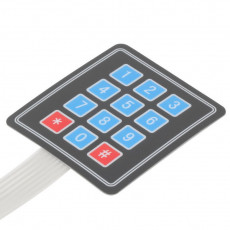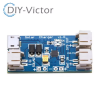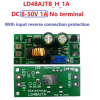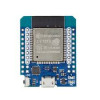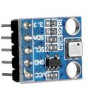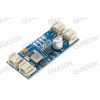4x3 matrix keypad
Pris:
kr. 20,00
 Features:
Features:
Contact resistance of 500 (¦Ø)
Insulation resistance 100M (¦Ø)
Key Operating Force 150-200N
Rebound time 1 (ms)
Life of 100 million (times)
Operating Temperature 60 degree
The electronic characteristics
Circuit Rating: 35V (DC), 100mA, 1W
Contact resistance: 10¦Ø ~ 500¦Ø (Varies according to the lead lengths and different from those of the material used)
Insulation resistance: 100M¦Ø 100V
Dielectric Strength: 250VRms (50 ~ 60Hz 1min)
http://playground.arduino.cc/Main/KeypadTutorial
#include
const byte ROWS = 4; //four rows
const byte COLS = 3; //three columns
char keys[ROWS][COLS] = {
{'1','2','3'},
{'4','5','6'},
{'7','8','9'},
{'#','0','*'}
};
byte rowPins[ROWS] = {5, 4, 3, 2}; //connect to the row pinouts of the keypad
byte colPins[COLS] = {8, 7, 6}; //connect to the column pinouts of the keypad
Keypad keypad = Keypad( makeKeymap(keys), rowPins, colPins, ROWS, COLS );
void setup(){
Serial.begin(9600);
}
void loop(){
char key = keypad.getKey();
if (key != NO_KEY){
Serial.println(key);
}
}
/*
|| Written by Dougie Kinnear November 2012
|| building on Nathan Sobieck’s|| Simple Password Entry Using Matrix Keypad
|| 4/5/2012 Updates Nathan Sobieck:
|| for other LCD’s. Control codes may also appear in the
|| serial monitor. See the Textstar data sheet for control codes|| This sketch is discussed on my blog
|| http://www.digitalmaker.co.uk/86/
|| look under the tags PIN, Textstar, Keypad
|| Please get in touch with any comments, suggestions etc.|| Many thanks to Nathan for sharing his work
*/
// # is to validate password/////////////////////////////////////////////////////////////////#include
#include
int redled(12);//———————- Keypad set up/mapping —————————Password password = Password(“1234”); // Set the password hereconst byte ROWS = 4; // Four rows
const byte COLS = 3; // columns
char keys[ROWS][COLS] = {
{‘1′,’2′,’3’},
{‘4′,’5′,’6’},
{‘7′,’8′,’9’},
{‘*’,’0′,’#’}
};byte rowPins[ROWS] = { 8,7,6,5}; // Assign board pins to keypad rows
byte colPins[COLS] = { 4,3,2}; // Assign board pins to keypad columnsKeypad keypad = Keypad( makeKeymap(keys), rowPins, colPins, ROWS, COLS );
//———————————————————void setup(){
{
pinMode(11, OUTPUT); //green light
pinMode(12, OUTPUT); //red light
Serial.begin(9600);
}
keypad.addEventListener(keypadEvent); //add an event listener for this keypaddelay(100); // A further delay to allow the LCD to initialiseSerial.write(254); // Tell LCD multiple command characters are coming
Serial.write(67); // Send a ‘C’ = Cursor set up command
Serial.write(4); // Set cursor to flashing underlinedigitalWrite(12, HIGH); // red LED on
delay(2000); // The LCD should be ready now – these delays can be alteredSerial.write(12); // This is a command to clear the screen and set the cursor to Line 1 column 1
Serial.println(“Enter a PIN then”); // Print the text to the screen
Serial.println(“press ‘#'”); // Print the text to the screen}void loop(){
keypad.getKey();
} void keypadEvent(KeypadEvent eKey){ // This is what happens during a keypad eventswitch (keypad.getState()){
case PRESSED:
Serial.print(eKey); // When a key is pressed * is printedswitch (eKey){
case ‘#’: checkPassword(); break; // press # to check entry
default: password.append(eKey);
}
}
}void checkPassword(){
if (password.evaluate()){ // If it’s correct do this
Serial.write(12);
Serial.println(“CORRECT”);
digitalWrite(12, LOW);
digitalWrite(11, HIGH);
delay(3000);
digitalWrite(11, LOW);
digitalWrite(12, HIGH);
password.reset(); // reset for next event
Serial.println(“Enter a PIN then”); // Print the text to the screen
Serial.println(“press ‘#'”); // Print the text to the screen
}
else{
Serial.write(12); // If it’s wrong do this
Serial.println(“INCORRECT”);
Serial.println(“TRY AGAIN”);
delay(50); // flash the red LED
digitalWrite(12,LOW);
delay(50);
digitalWrite(12, HIGH);
delay(50);
digitalWrite(12,LOW);
delay(50);
digitalWrite(12, HIGH);
delay(50);
digitalWrite(12,LOW);
delay(50);
digitalWrite(12, HIGH);
delay(50);
digitalWrite(12,LOW);
delay(50);
digitalWrite(12, HIGH);
delay(50);
digitalWrite(12,LOW);
delay(50);
digitalWrite(12, HIGH);
delay(50);
digitalWrite(12,LOW);
delay(50);
digitalWrite(12, HIGH);
delay(50);
digitalWrite(12,LOW);
delay(50);
digitalWrite(12, HIGH);
delay(50);
digitalWrite(12,LOW);
delay(50);
digitalWrite(12, HIGH);
delay(50);
digitalWrite(12,LOW);
delay(50);
digitalWrite(12, HIGH);
delay(50);
digitalWrite(12,LOW);
delay(50);
digitalWrite(12, HIGH);
delay(50);
digitalWrite(12,LOW);
delay(50);
digitalWrite(12, HIGH);
delay(50);
digitalWrite(12,LOW);
delay(50);
digitalWrite(12, HIGH);
delay(50);
digitalWrite(12,LOW);
delay(50); // stop flashing the red LED
digitalWrite(12, HIGH);
password.reset(); // reset for next event
delay(2500);
Serial.println(“Enter a PIN then”); // Print the text to the screen
Serial.println(“press ‘#'”); // Print the text to the screen}
}

